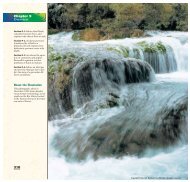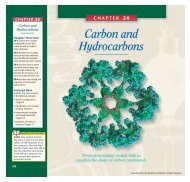Physical Characteristics of Gases
Physical Characteristics of Gases
Physical Characteristics of Gases
You also want an ePaper? Increase the reach of your titles
YUMPU automatically turns print PDFs into web optimized ePapers that Google loves.
SAMPLE PROBLEM 10-2<br />
SOLUTION<br />
1 ANALYZE<br />
2 PLAN<br />
3 COMPUTE<br />
4 EVALUATE<br />
PRACTICE<br />
P1V1 P2 =<br />
(1.0 atm)(1.0 L)<br />
P2 = = 0.20 atm<br />
5.0 L<br />
The pressure has decreased to one-fifth the original pressure, while the<br />
volume increased fivefold.<br />
A sample <strong>of</strong> oxygen gas has a volume <strong>of</strong> 150. mL when its pressure is 0.947 atm. What will<br />
the volume <strong>of</strong> the gas be at a pressure <strong>of</strong> 0.987 atm if the temperature remains constant?<br />
Given: V 1 <strong>of</strong> O 2 = 150. mL<br />
P 1 <strong>of</strong> O 2 = 0.947 atm; P 2 <strong>of</strong> O 2 = 0.987 atm<br />
Unknown: V 2 <strong>of</strong> O 2 in mL<br />
Copyright © by Holt, Rinehart and Winston. All rights reserved.<br />
V 2<br />
P 1 , V 1 , P 2 ⎯→ V 2<br />
Rearrange the equation for Boyle’s law (P 1 V 1 = P 2 V 2 ) to obtain V 2 .<br />
P1V1 V2 =<br />
Substitute values for P 1 , V 1 , and P 2 to obtain the new volume, V 2 .<br />
P1V1 (0.947 atm)(150. mL O2 )<br />
V2 = = = 144 mL O2 0.987 atm<br />
P 2<br />
When the pressure is increased slightly at constant temperature, the volume decreases<br />
slightly, as expected. Units cancel to give milliliters, a volume unit.<br />
1. A balloon filled with helium gas has a volume <strong>of</strong> 500 mL at a pressure<br />
<strong>of</strong> 1 atm. The balloon is released and reaches an altitude <strong>of</strong> 6.5 km,<br />
where the pressure is 0.5 atm. Assuming that the temperature has<br />
remained the same, what volume does the gas occupy at this height?<br />
2. A gas has a pressure <strong>of</strong> 1.26 atm and occupies a volume <strong>of</strong> 7.40 L. If<br />
the gas is compressed to a volume <strong>of</strong> 2.93 L, what will its pressure be,<br />
assuming constant temperature?<br />
3. Divers know that the pressure exerted by the water increases about<br />
100 kPa with every 10.2 m <strong>of</strong> depth. This means that at 10.2 m below<br />
the surface, the pressure is 201 kPa; at 20.4 m, the pressure is 301 kPa;<br />
and so forth. Given that the volume <strong>of</strong> a balloon is 3.5 L at STP and<br />
that the temperature <strong>of</strong> the water remains the same, what is the volume<br />
51 m below the water’s surface?<br />
P 2<br />
Answer<br />
1000 mL He<br />
Answer<br />
3.18 atm<br />
Answer<br />
0.59 L<br />
PHYSICAL CHARACTERISTICS OF GASES 315<br />
ADDITIONAL<br />
SAMPLE<br />
PROBLEMS<br />
SECTION 10-3<br />
10-2 The piston <strong>of</strong> an internal combustion<br />
engine compresses 450. mL<br />
<strong>of</strong> gas. The final pressure is 15 times<br />
greater than the initial pressure.<br />
What is the final volume <strong>of</strong> the gas,<br />
assuming constant temperature?<br />
(Treat “15 times” as a pure number,<br />
with unlimited significant figures.)<br />
Ans. 30.0 mL<br />
10-2 A helium-filled balloon contains<br />
125 mL <strong>of</strong> gas at a pressure<br />
<strong>of</strong> 0.974 atm. What volume will the<br />
gas occupy at standard pressure?<br />
Ans. 122 mL<br />
10-2 A weather balloon with a<br />
volume <strong>of</strong> 1.375 L is released from<br />
Earth’s surface at sea level. What<br />
volume will the balloon occupy at<br />
an altitude <strong>of</strong> 20.0 km, where the<br />
air pressure is 10.0 kPa?<br />
Ans. 13.9 L<br />
315

















